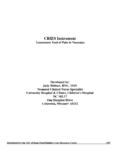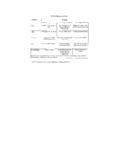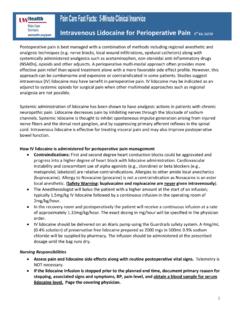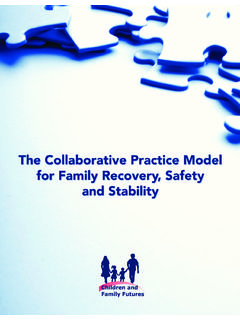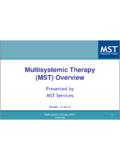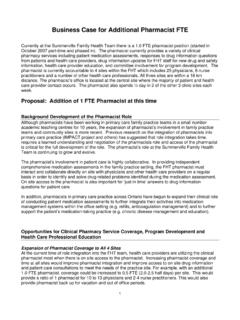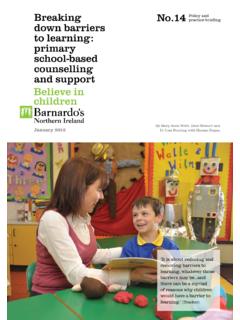Transcription of Bereavement Risk Assessment Guidelines
1 Guidelines for the Assessmentof Bereavement Risk in FamilyMembers of People ReceivingPalliative CareCentre for Palliative CareJuly 2000 Guidelines for the Assessment of Bereavement Risk in family members of People Receiving Palliative Care1 AcknowledgmentsThis project was made possible by a grant from the Department of Human Guidelines could not have been written without the cooperation of practitionerswho work with people who are dying and their families. Practitioners were willing toexamine their practice and identify areas of strength and weakness. Special thanks arealso offered to the members of the project steering committee whose thoughtful inputguided the project and opened doors to many areas of the literature and national andinternational experts in the Committee MembersAssociate Professor Sanchia Aranda (Principal Investigator) Centre for PalliativeCareProfessor Sidney Bloch The University of MelbourneMs Julie Edwards Outreach Grief ServicesMr Chris Hall Centre for Grief EducationProfessor David Kissane Centre for Palliative CareMs Donna Milne (Project Officer)
2 Centre for Palliative CareRev Dr Bruce Rumbold Palliative Care Unit La Trobe UniversityReview PanelDr Louis Gamino Scott and White Clinic Texas, USADr Selby Jacobs Yale University, USAP rofessor Linda Kristjanson - Edith Cowan University, WAMs Barbara Monroe St Christopher s Hospice London, UKDr Judith Murray University of QueenslandDr Holly Prigerson Yale University, USAP rofessor Beverley Raphael New South Wales Health DepartmentMs Patsy Yates Queensland University of TechnologyClinical ReviewersMr Mark Cockayne Bethlehem Community Palliative Care ServiceMs Jill Davidson Hume Region Palliative CareMs Judith Hind-Roff Peninsula Hospice ServiceMs Cath Tomlinson - Bethlehem Community Palliative Care ServiceHow to cite this documentAranda, S & Milne, D (2000) Guidelines for the Assessment of complicatedbereavement risk in family members of people receiving palliative care. Melbourne:Centre for Palliative for the Assessment of Bereavement Risk in family members of People Receiving Palliative Care2 Table of ContentsEXECUTIVE SUMMARY--------------------------------- -------------------------------- 0 PART 1 ---------------------------------------- ---------------------------------------- -------- 0 INTRODUCTION ---------------------------------------- ----------------------------------- 0 CHAPTER 1 ---------------------------------------- ---------------------------------------- -- 0 THE APPROACH TO COMPLICATED Bereavement RISKASSESSMENT ---------------------------------------- --------------------------------------- IS RISK?
3 ---------------------------------------- ------------------------------- IS RISK OF COMPLICATED Bereavement ? ------------------------------- IS RISK Assessment ?----------------------------- -------------------------- IS MEANT BY RISK OF COMPLICATED Bereavement OUTCOMES? ---- IS IT IMPORTANT TO TARGET Bereavement INTERVENTIONS? --------- ARE THE IMPLICATIONS OF CBRA? --------------------------------------- 0 CHAPTER 2 ---------------------------------------- ---------------------------------------- -- 0 THE Guidelines ---------------------------------------- --------------------------------- WAS THE EVIDENCE RATED?---------------------------------- --------------- WILL USE THE Guidelines ? ---------------------------------------- --------- CAVEAT WHEN READING THESE Guidelines ------------------------------ ---- OF Guidelines ------------------------------ --------------------------- 0 CHAPTER 3 ---------------------------------------- ---------------------------------------- -- 0 IMPLEMENTATION OF THE Guidelines --------------------------------------- ELEMENTS FOR SUCCESSFUL IMPLEMENTATION-------------------------- TO GUIDELINE IMPLEMENTATION-------------------------- ----------- 0 PART 2 ---------------------------------------- ---------------------------------------- -------- 0 CHAPTER 4 ---------------------------------------- ---------------------------------------- -- 0 THEORIES OF GRIEF AND Bereavement ------------------------------------- THEORY---------------------------------- ----------------------- THEORIES-------------------------------- -------- ORIENTED
4 THEORIES-------------------------------- ----------- THEORY---------------------------------- -------------------------- USED TO DESCRIBE THE GRIEF PROCESS------------------------------- VERSUS ABNORMAL GRIEF----------------------------------- ----------- COMPLICATED GRIEF FROM OTHER DISORDERS------------ 0 SUMMARY--------------------------------- ---------------------------------------- ---------- 0 Guidelines for the Assessment of Bereavement Risk in family members of People Receiving Palliative Care3 CHAPTER 5 ---------------------------------------- ---------------------------------------- -- 0 LITERATURE REVIEW ---------------------------------------- -------------------------- OF THE ILLNESS, TERMINAL CARE AND NATURE OF THEDEATH-------------------------------- ---------------------------------------- -------- OF THE BEREAVED-------------------------------- ------------ RELATIONSHIPS--------------------------- ----------------------- OF THE DECEASED-------------------------------- ------------ 0 APPENDICES ---------------------------------------- ---------------------------------------- 0 APPENDIX 1: STEERING COMMITTEE TERMS OF REFERENCE --------- 0 APPENDIX 2: SEARCH STRATEGY ---------------------------------------- ---------- 0 APPENDIX 3: FOCUS GROUPS ---------------------------------------- ---------------- 0 APPENDIX 4.
5 TELEPHONE SURVEY ---------------------------------------- -------- 0 APPENDIX 5 - INVENTORY OF TRAUMATIC GRIEF (ITG) ------------------ 0 APPENDIX 6 - RISK FACTORS FOR COMPLICATED BEREAVEMENTOUTCOMES CHECKLIST ---------------------------------------- ----------------------- 0 APPENDIX 7: THE family RELATIONSHIPS INDEX (FRI) (MOOS &MOOS, 1981).---------------------------------- ---------------------------------------- ------- 0 APPENDIX 8 PROPOSED CRITERIA FOR TRAUMATIC GRIEF ---------- 0 REFERENCES ---------------------------------------- --------------------------------------- 0 Guidelines for the Assessment of Bereavement Risk in family members of People Receiving Palliative Care4 Executive SummaryAustralia is predominantly a healthy country. Age-standardised death rates more thanhalved in the period 1921-1992 and continue to fall. Males born in 1992 could expectto live until years and females to years1. However, it is a universal truththat each of us will die and those who are in a relationship with us will be affected byour care of people who are dying and their families is an important health care issuereflected in the commitment by Federal and State Governments to making palliativecare services available to all Australians.
6 Improvements in the delivery of palliativecare to dying Australians have led to a closer examination of the needs of bereavedfamily members. The Victorian State Government has also risen to this challenge byproviding significant increases in funding for Bereavement Guidelines aim to assist providers of services to families of dying people toidentify family members at risk of complicated Bereavement outcomes based on bestavailable evidence. The Guidelines were developed through a comprehensive reviewof the available evidence on risk factors associated with complicated bereavementoutcomes and through an expert review other evidence-based Guidelines , these Guidelines are not predominantlyconcerned with making recommendations about interventions, but with establishing aprocess of complicated Bereavement risk Assessment to guide effective use ofresources. As a result these Guidelines draw predominantly from expert opinion(Level IVb evidence) about the process of Bereavement risk Assessment , whileguideline 3 outlining risk factors draws on Level III and IVa evidence gained fromcohort and descriptive studies exploring Bereavement outcomes.
7 The process outlinedin the Guidelines provides a useful framework for the development of interventionresearch in the report will provide a valuable resource for the delivery of services to dyingpeople and their families. In addition to the Guidelines , the report contains anoverview of guideline implementation, an outline of key Bereavement theoriesnecessary to interpretation of risk factors and a summary of the literature on of the Guidelines has the potential to ensure family members at risk ofcomplicated Bereavement outcomes will be identified early, facilitating earlyintervention approaches to Bereavement support. Most of the guidelinerecommendations require a refocusing of existing services rather than additionalpersonnel or infrastructure. It is hoped the Guidelines will stimulate considerablereflection within the health care system about the process of Bereavement riskassessment and empower health professionals to work more effectively with familymembers in risk for the Assessment of Bereavement Risk in family members of People Receiving Palliative Care5 Part 1 Guidelines for the Assessment of Bereavement Risk in family members of People Receiving Palliative Care6 IntroductionThe aim of this project was to develop Guidelines to assist palliative care providers toidentify family members at risk of complicated Bereavement outcomes.
8 Identificationof the risk of complicated Bereavement outcomes in people utilising palliative careservices is a Victorian and Australian performance indicator2. This performanceindicator asks services to record the number of people they assess as being at risk ofcomplicated Bereavement outcomes. The Assessment of risk for complicatedbereavement assists targeting of services to those at high risk, although not all at riskindividuals will be available for Assessment or the project focuses on the specialist palliative care context the Guidelines areapplicable to any setting involved in the care of people who are dying, for example inaged care. The project was commissioned by the Victorian Department of HumanServices as one part of a program of research aimed at improving the provision ofbereavement services (Appendix 1). The impetus for the project was growing concernabout the significant variability in the provision of Bereavement support across.
9 Theissue of complicated Bereavement risk Assessment is seen as an important first step indetermining the need for Bereavement services and in assisting with targeting servicesto those most in need. The establishment of such risk in any individual is underpinnedby several important assumptions that require elaboration. These are that:1. Risk for complicated Bereavement outcomes can be identified in family membersexperiencing the loss of a person significant to Grief is a normal reaction to Bereavement , which is usually managed effectivelyby the family members concerned. Where there is no or little indication of highrisk for complicated outcomes family members should be offered education andinformation about normal grief and access to general Where high risk of complicated outcomes is identified, these individuals andfamilies should be offered more intensive support and access to bereavementcounselling services.
10 Such targeting of services is at present a theoreticalprinciple partially supported by observational studies but not randomised Bereavement literature dealing with risk factors is a complex, highly varied bodyof work spanning more than four decades. The quality of the research is mixed andlittle rates above Level IV on a hierarchy of evidence (Section ). Given theexploratory and descriptive nature of such research this is not altogether surprising,although study quality is still hampered by frequent absence of an appropriate controlgroup and/or pre-death baseline data for comparison of outcomes. This makes itdifficult to determine if measured variables are pre-existing or result from the research exists, the predominant focus is on analysis of demographic variablessuch as age and gender, which are easy to measure but offer little direction forGuidelines for the Assessment of Bereavement Risk in family members of People Receiving Palliative Care7interventions.
